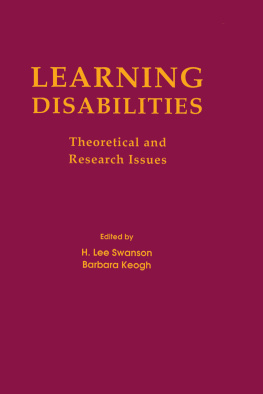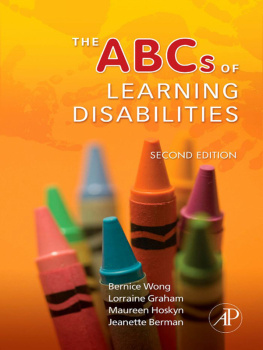Keogh Barbara K. - Learning disabilities: theoretical and research issues
Here you can read online Keogh Barbara K. - Learning disabilities: theoretical and research issues full text of the book (entire story) in english for free. Download pdf and epub, get meaning, cover and reviews about this ebook. City: London Routledge, year: 2016, publisher: Taylor and Francis, genre: Children. Description of the work, (preface) as well as reviews are available. Best literature library LitArk.com created for fans of good reading and offers a wide selection of genres:
Romance novel
Science fiction
Adventure
Detective
Science
History
Home and family
Prose
Art
Politics
Computer
Non-fiction
Religion
Business
Children
Humor
Choose a favorite category and find really read worthwhile books. Enjoy immersion in the world of imagination, feel the emotions of the characters or learn something new for yourself, make an fascinating discovery.
- Book:Learning disabilities: theoretical and research issues
- Author:
- Publisher:Taylor and Francis
- Genre:
- Year:2016
- City:London Routledge
- Rating:4 / 5
- Favourites:Add to favourites
- Your mark:
- 80
- 1
- 2
- 3
- 4
- 5
Learning disabilities: theoretical and research issues: summary, description and annotation
We offer to read an annotation, description, summary or preface (depends on what the author of the book "Learning disabilities: theoretical and research issues" wrote himself). If you haven't found the necessary information about the book — write in the comments, we will try to find it.
Learning disabilities: theoretical and research issues — read online for free the complete book (whole text) full work
Below is the text of the book, divided by pages. System saving the place of the last page read, allows you to conveniently read the book "Learning disabilities: theoretical and research issues" online for free, without having to search again every time where you left off. Put a bookmark, and you can go to the page where you finished reading at any time.
Font size:
Interval:
Bookmark:

Theoretical and Research Issues
DISABILITIES:
Theoretical and Research
Issues
Edited by
H. LEE SWANSON
UNIVERSITY OF BRITISH COLUMBIA
BARBARA KEOGH
UNIVERSITY OF CALIFORNIA, LOS ANGELES

First Published by
Lawrence Erlbaum Associates, Inc., Publishers
10 Industrial Avenue
Mahwah, New Jersey 07430
Transferred to Digital Printing 2009 by Routledge
270 Madison Avenue New York, NY 10016
2 Park Square Milton Park, Abingdon Oxon OX14 4RN
Copyright 1990 by Lawrence Erlbaum Associates, Inc.
All rights reserved. No part of this book may be reproduced in any form, by photostat, microform, retrieval system, or any other means without the prior written permission of the publisher.
Library of Congress Cataloging-in-Publication Data
Learning disabilities: theoretical and research issues / edited by
H.L. Swanson, Barbara Keogh,
p. cm.
The incentive for this text was the result of a 1988 conference sponsored by the International Academy for Research in Learning Disabilities, held at the University of California, Los Angeles Pref.
Includes bibliographical references.
ISBN 0-8058-0392-0
1. Learning disabilitiesCongresses. I. Swanson, H. Lee, 1947. II Keogh, Barbara K. III. International Academy for Research in Learning Disabilities.
LC4704.L413 1990
371.9dc20
89-37575
CIP
Publisher's Note
The publisher has gone to great lengths to ensure the quality of this reprint but points out that some imperfections in the original may be apparent.
The purpose of this text is to provide a review and critique of the current state of research in the areas of intelligence, social cognition, and achievement as it relates to learning disabilities. Specific attention is also paid to developments in an area of subtyping research. The chapters are up to date with regard to theoretical and technical developments in the field of learning disabilities and yet readable for anyone with a reasonable scientific background. The incentive for this text was the result of a 1988 conference sponsored by the International Academy for Research in Learning Disabilities, held at the University of California at Los Angeles. The 3-day conference was organized primarily around symposium topics that focused on the areas of intelligence, motivation and social cognition, and methodological issues in subtyping research. Within each session, either three or four papers were presented. This was followed by an open discussion of conference participants and a predesignated discussant. The same organization that was used in the conference serves as the structure for the text. A separate section of individual papers devoted to issues related to achievement also merged as an area with emerging technical advances. A small number of these papers are included in this text. Although two of the papers in this latter section do not have an isolated focus on achievement, per se, we included them because of their important contribution to the literature.
As a beginning point in our discussion related to the symposium topics, we would like to suggest that major theoretical advances have occurred in our understanding of learning disabilities. The progress we see is reciprocalin which practical issues of diagnosis and intervention are beginning to become tightly intertwined with theory. Individuals in cognitive science, for example, and learning disabilities, are beginning to profit from collaborative efforts. No doubt, this progress has occurred in the face of difficulties associated with defining and diagnosing learning disabilities. As suggested in the first chapter by Keogh, this is because the integration and evaluation of findings from diverse orientations is complicated considerably when researchers cannot determine whether inconsistent or contradictory results are due to the heterogeneity in the LD sample or to deficiencies in their theories. Given the substantial dilemmas posed by inexact, incomplete and overlapping definitions of learning disabilities, that progress has occurred might be surprising. The following chapters, however, suggest that a much closer connection between the formulations of theory and learning disabilities are occurring. These advances in our conceptions of theories about areas of cognition, and achievement, for example, will, we hope, lead to improved diagnostic practices, which in turn should result in refined subject selection criteria and further theoretical progress. With this as an introduction, we would like to summarize the salient points of each chapter.
In the first chapter, Keogh provides an overview of federal financial resources that have been allocated toward the research of learning disabilities. Unfortunately, research from the various funding agencies (e.g., National Institutes of Health, U. S. Department of Education) has been motivated from psychological, neuropsychological, educational, or biomedical perspectives that have not been interactive with each other. One reason for this interative work on learning disabilities, especially when it comes to translations into clinical and educational applications, relates to such issues as identification, classification and the heterogeneity of the learning disabled population. In an attempt to enhance interactive efforts across various orientations, Keogh suggests that some common assumptions must be shared. Some of these assumptions are: (1) the locus of the learning disability is in the individual, (2) learning disabled individuals do not function at levels consistent with their intellectual potential, and (3) learning disabled individuals exhibit unexpected failures in specific academic or educational tasks. Keogh suggests that several steps are necessary if one is to encourage the integration of various approaches to learning disabilities. Some of these steps include (1) detailing the primary attributes that distinguish learning disabilities from other conditions, (2) providing a detailed and comprehensive taxonomy (also see chapters by Speece, Kavale, and Forness) of the heterogeneity within learning disabilities, (3) searching for viable aptitude-treatment interactions, (4) relating learning disabilities to the content and structure of learning tasks (also see Ceci, Pelligrino, and Goldman, this volume), (5) testing competing models of treatment, instruction or intervention, and (6) documenting the longitudinal course of learning problems. Unless progress is made in some of these areas there will be minimal cross over effects between various perspectives (psychological, neuropsychological, biomedical).
In the first section of the text, Swanson provides an introduction to the area of intelligence. Several issues are raised related to measuring intelligence, but the majority of those issues revolve around what is meant by a specific versus a general learning deficit. Differential approaches to understanding learning disabled children's intellectual deficits are criticized because (a) they provide global constellation of performances that are insensitive to the specific processes necessary for learning, and (b) isolated performance deficits are most likely related to Matthew Effects. It is suggested that disabled children's intelligence may be best understood within a framework that focuses on the accessing of information and the monitoring or coordination of resources. While it is argued that specific models are critical to the field, and may in fact underlie monitoring or high order deficits, a focus on monitoring process that coordinate multiple resource pools is also an important area of research focus (see Ceci, this volume, for a related discussion). The contribution of information processing models to our understanding of intelligence was described in terms of knowledge representation, response consistency, domain expertise, intellectual competence, and subtle , it is noted that integrative and reciprocal work is beginning to occur between researchers in the areas of intelligence and learning disabilities. The aims of the following 4 chapters on intelligence details the direction to this reciprocal process.
Font size:
Interval:
Bookmark:
Similar books «Learning disabilities: theoretical and research issues»
Look at similar books to Learning disabilities: theoretical and research issues. We have selected literature similar in name and meaning in the hope of providing readers with more options to find new, interesting, not yet read works.
Discussion, reviews of the book Learning disabilities: theoretical and research issues and just readers' own opinions. Leave your comments, write what you think about the work, its meaning or the main characters. Specify what exactly you liked and what you didn't like, and why you think so.




